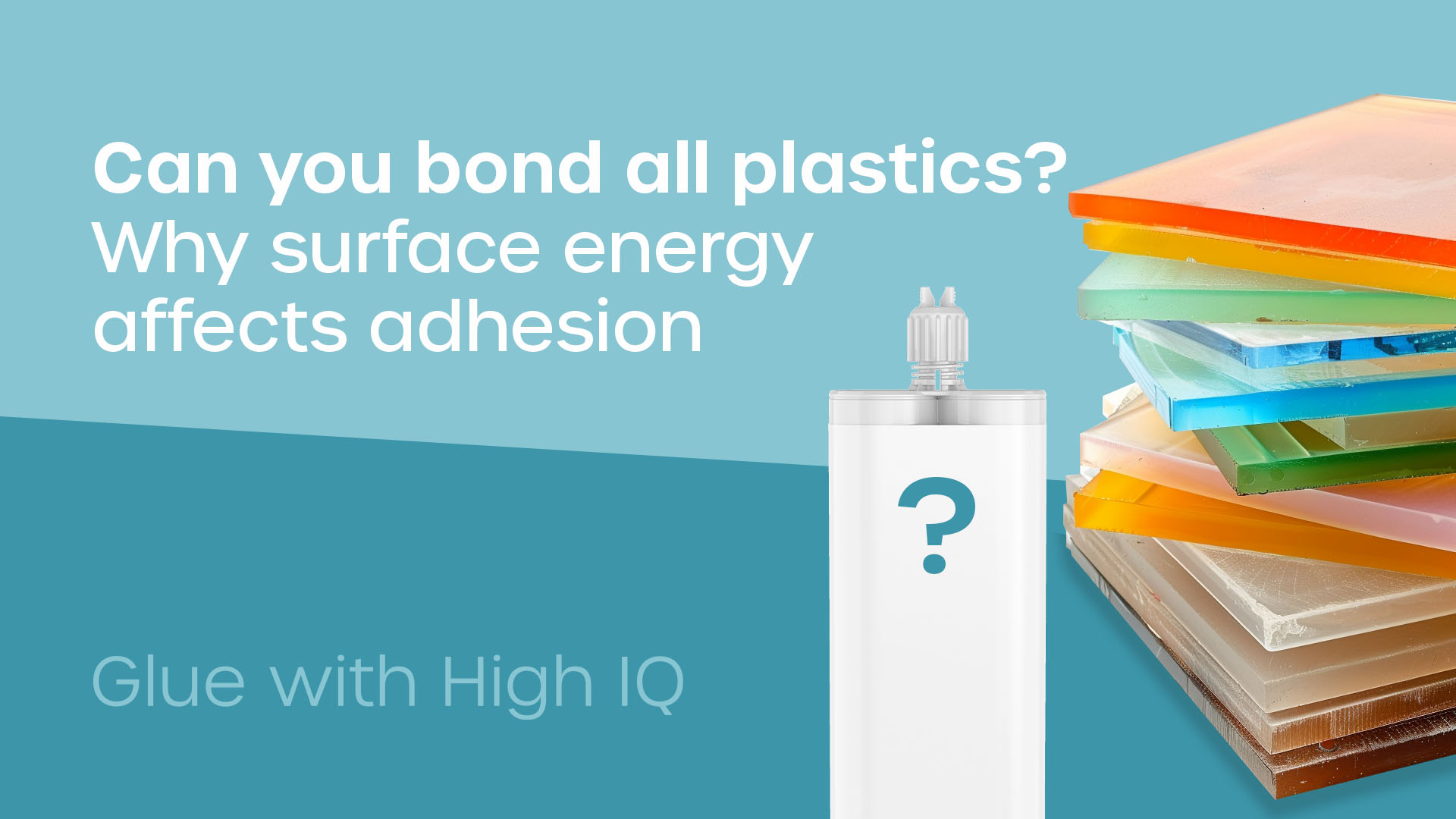Can you bond all plastics? And why Surface Energy affects Adhesion

As with all difficult questions, there is no simple answer. The question around how to bond plastics is no different, but the simple answer is yes, you can bond all plastics. Over the years, hundreds of puzzled manufacturers have asked us here at Forgeway the answer to that question. If you have also been struggling to bond plastics and cannot understand the reason why, you’re in luck! We wrote this article to help you.
Because this question crops up so frequently, we are aware of the different solutions available. We also understand it can be difficult for you to easily find the answer. That’s why this article will discuss the reasons why plastic adhesion can be difficult.
And by the end of this article, you will have read through the different solutions to improve adhesion. We know you will then be in a better position to determine what to do next.
Surface Energy’s role in Bonding Failure
The main reason behind the failure to bond some plastics is due to their surface energy. It’s worth noting that this isn’t the only reason the adhesion fails. However, if the surface energy of the adhesive is significantly more than that of the plastic, it is likely to result in poor adhesion. This is regardless of the other factors at play. The surface energy ultimately decides whether you can (or can’t) bond plastics.
To briefly explain surface energy in simple terms, it is a relative measurement of the energy at the surface of a product. Of course, there is much more to surface energy than that. But for the purpose of the question at hand, we will move on to why surface energy affects the adhesion of plastics.
Disclaimer If you want to learn more about plastic bonding, make sure you sign up for the Plastic Bonding Masterclass webinar. It will help you become the plastic bonding expert.
Measuring Surface Energy and how it affects Adhesion
Surface energy is literally the amount of energy present in millijoules per area in square metres. Therefore it has the units mJ/m2. The two main categories of plastics are High Surface Energy (HSE) plastics, and Low Surface Energy (LSE) plastics.
As a general rule of thumb, we would class plastics with a surface energy of 38 or above as a HSE plastic. Plastics with a surface energy of 37 or below would be classed as an LSE plastic.
Generally, it’s relatively easy to find a structural adhesive that would bond plastics classed as HSE. So long as you have clearly defined the requirements of that adhesive, there shouldn’t be many problems.
But when the material has a surface energy below 37, that’s when the problems occur. This is because it’s very difficult to find adhesives with surface energy below 37 mJ/m². As discussed earlier, the surface energy of the adhesive must be lower than that of the substrate for it to bond sufficiently.
That is why you cannot bond some plastics with common adhesives and many struggle with finding solutions to their bonding requirements.
But what are some examples of LSE plastics and what can you do about them?
Examples of Low Surface Energy Plastics
Without listing each individual type of plastic and its rating, the LSE plastics that are most commonly used are Polystyrene (surface energy = 36 mJ/m²), Polypropylene (surface energy = 29 mJ/m²), and PTFE, also known as Teflon (surface energy = 18mJ/m²). The image on the right shows some of the commonly used plastics have a surface energy below 37 mJ/m².
The lower the surface energy, the greater the difficulty in bonding that plastic substrate.

Improving Adhesion to Low Surface Energy Plastics
Bearing in mind that we aren’t saying the following solutions will solve the issue that you may currently be facing. They have worked with other situations where it has been traditionally difficult to bond plastics with a Low Surface Energy. They could be the answer for you.
The most common method is to increase the surface energy. You may well be wondering how on earth that is achieved, but it is relatively simple. This solution is known as Surface Pretreatment and comes in the following forms.
- Mechanical pretreatment is one such method of increasing surface energy. It consists of sandblasting, sanding, or grinding the plastic to change the roughness and surface area of the bond. It is often considered the most viable solution for small areas or in situations where you can quickly treat an area through the use of specialist equipment. However, Mechanical pretreatment can cause structural damage to plastic components. It is usually found to not provide sufficient bond strength. This is because the substrate ultimately still has a surface energy significantly lower than that of the adhesive. It is also not usually enough to increase the surface energy by a significant amount for very low surface energy plastics. Therefore, this method may not be a suitable solution for your bonding issues.
- Chemical pretreatment involves dipping the plastic into acid or ‘acid etching’ to remove a loose layer of oxide from its surface. There aren’t as many drawbacks as mechanical pretreatment, but the cost of the chemicals and specialist equipment – in addition to the time taken to prepare the surface for adhesion – can be significant. However, it does work. And many manufacturers use it to prepare their LSE plastics as it is much more effective than mechanical pretreatment.
- The third form of pretreatment is known as ‘Physical Surface Treatment’. This involves chemically changing the surface by exposing it to flame, corona discharge or plasma. It is an effective solution that is also widely used but does have its drawbacks. The specialist equipment required is often associated with high costs, it is also time-consuming, and there is a finite time window in which you can bond the surface following treatment.
Formulating adhesives to have a very low surface energy
So are there any other options available?
Yes, there are. And the options include products that we at Forgeway provide. This isn’t just us blowing our own trumpet, adhesive manufacturers (and not just us) have been able to create adhesives with extremely low surface energies over the years.

Recent academic developments have demonstrated the available solutions. However, the difficulty has been taking this solution and making it commercially available. It is a possibility though. So is this any better than the pretreatment methods?
It’s not necessarily better or worse, it just provides a different set of advantages and drawbacks. The obvious advantage is the time and money you can save without having to go through the pretreatment process. This adhesive will not require any of the special surface pretreatments before application.
But Low Surface Energy adhesives may be more costly depending on the application and volumes used. The time, research, and resources required to create the adhesive will ultimately result in a costly product.
Surface Pretreatment or Specialist Adhesive: Which solution is best for you?
You need to take multiple considerations into account when deciding what the next steps are. Ultimately the answer is yes, you can bond all plastics. But as we have outlined above, there is no simple solution to the issue presented by Low Surface Energy plastics when it comes to bonding.
We hope that we have been able to help you weigh up which solution best suits you by demonstrating the positives and negatives of the potential solutions available. And as Forgeway has had years of experience dealing with this issue, we feel that our expertise on this issue will help you find a suitable solution to meet your needs. We even created an adhesive product that has a very low surface energy. This may be the solution that best suits your needs.
The decision ultimately lies with you. If you think that surface pre-treatment is the best solution, we advise you to read through the different methods in more detail and assess how you should implement this in your company. If you think that a specialist adhesive will solve the problem, we would suggest having a chat with one of our technical consultants or if you want to do some more research, there are some excellent articles on LSE adhesive solutions.
Whatever solution you may be thinking of or if you are still deciding, we understand that no two bonding problems are the same. We know it can be incredibly frustrating when you can’t find the answer.
If you feel as though we haven’t discussed your particular problem and your issue is uniquely different, make sure you click the button below. It will take you to the Plastic Bonding Masterclass page where you can sign up to our free webinar.
You will learn everything you need to know about Plastic Bonding. Sign up below…
Thomas is the Content Manager here at Forgeway. Thomas' job is to translate the technical jargon from the ivory tower of academia into easy-to-read content that everyone can understand. Forgeway's mission is to answer every question our customers and prospective clients ask, or are apprehensive to ask.
Topics:



